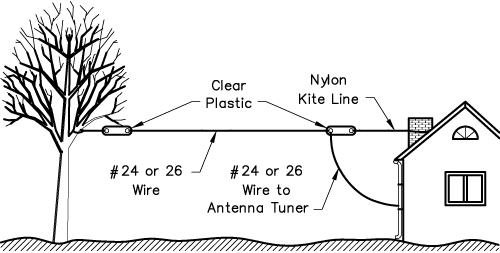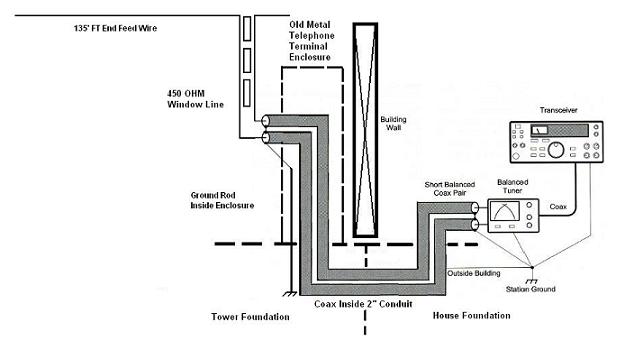I have lived in just about every kind of building you
can imagine. I have lived in old apartments, new style apartments, mobile
homes, houses, and even an old converted hotel. In each instance, I always
tried to have fun with my radio hobby.
One antenna that I have always used with good results was an end fed random
wire. A random wire is just any old length of wire that runs from a support
to the back of a tuner and fed to an HF transceiver.

I've used dipoles and verticals, but the random
wire has always done in a pinch.
The random wire is not without it's draw backs. I
have had problems in the past with RF in the shack resulting in "RF bites"
from my equipment. This also means interference to and from other electrical
appliances. There are ways to work around some of these problems, but the
user of these antennas has to realize there are limitations. Sometimes I
have been limited to one band for transmitting.
My old set up had been the use of a random wire in
my attic. It worked well on most HF bands. However, as stated above, I was
picking up every noise you can think of in the attic. TV set, computers,
heating and air conditioning, etc. So I was thinking it was time to go
outside with my wire antennas.
I could have put up a dipole but I didn't
want any wires going out to the front yard. Besides, the antennas I was
going to put up was effectively a half wave antenna like the dipole. The
only difference is that the half wave dipole is fed in the middle and the
half wave I wanted to erect was a half wave fed on the end.
This is where the similarities between my old
antenna and the new one end. The new antenna would be "resonant" instead of
just a random wire. And instead of the antenna terminating at the back of my
antenna tuner, it would have a feed line.

The new antenna would have a open feeder type feed
line. I had some 450 ohm window line that most stations use, so I decided to
give it a try. One thing I read about open type feeders is that they are very
efficient. That means the losses are very low even when the mismatch between
the antenna and feed line are high. However, they are effected by weather
and close metal objects like towers or electrical wiring. Spacing the window
line from the tower was not going to be a problem, but running it inside
was. If it was brought in through the attic, there were going to be a lot of
electrical lines and telephone lines near the closest entry point. Not to
mention all the ac/heat ducts running everywhere. It was starting to look
like I should just stick with a random wire.
Coax has the advantage of being routed into areas
of my attic that I mentioned previously. It can be attached to a tower leg
and run to the antenna. The draw back is that it would make my antenna a
monobander or good on only one band. Coax is also very lossy when you get a
huge mismatch.
I had seen online where people made a feed through
line
of two coaxial cables. These side by side coaxial lines made it where an open feeder could pass through a
wall. I didn't find much info on the subject. It is possible to do it, but
some losses can be introduced to the system if the run is too long. I
calculated my run to be about eight to ten feet, so I decided to give it a
try.
